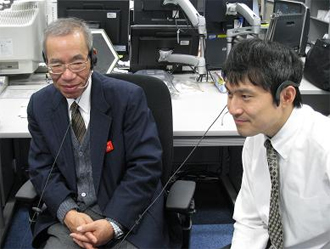This is an archive of information released in the past.
Disclaimer: It may contain broken links or outdated information. Some parts may not function in current web browsers.
*Visit https://humans-in-space.jaxa.jp/en/ for the latest information.

Experiment
- News
- Kibo Utilization Strategy
- Kibo Utilization Plan
- List of JAXA's Utilization Themes
- Experiment Facilities
- Space Environment Utilization
- Archive
Rad Silk Began onboard Kibo
* Dates and times are given in Japan Standard Time (JST)
During the night of November 17, 2009, Rad Silk*1, JAXA's life science experiment that examines biological effects of space radiation using Cell Biology Experiment Facility (CBEF), began onboard Kibo.
*1 Integrated assessment of long-term cosmic radiation through biological responses of the silkworm, Bombyx mori, in space
(Principal Investigator: Toshiharu Furusawa, Kyoto Institute of Technology University)
Rad Silk experiment began at 9:18 p.m. on November 17, 2009.
This experiment aims at determining effects of space radiation (such as occurrences of mutation, malformation, and alteration in gene expression due to exposure to space radiation) on silkworm eggs. To this end, silkworm eggs in a state of diapausing were delivered to the International Space Station (ISS).
In this experiment, overwintering, or diapausing, eggs are delivered to the ISS to have them develop embryos in space. Then, the eggs will be returned to Earth and their life cycles, from eggs to hatched larvae, pupae and imagoes, will be observed on the ground.
Ground-based studies performed as preliminary study for this experiment showed that silkworm egg during the early stage of embryo development (two to five days after diapause break) is highly sensitive to radiation exposure.
After completing the in-flight experiment onboard the ISS, the eggs will be returned to the ground to let the eggs to hatch on the ground. The hatched worms will be artificially raised to examine their life cycle. It could clarify the relation between radiation effects and their mutations, and study the subsequent effects on the next generation worms.
In the in-flight experiment, various gene expressions will occur during the embryo development stage, however, we will focus on p53 gene expression*2 and space radiation impacts.
Rad Silk experiment onboard the ISS will continue until November 23, 2009.
*2 p53 gene is a tumor suppression gene, which is involved in cell growth and apoptosis (programmed cell death). p53 has been described as "the guardian of the genome", "the guardian angel gene", referring its role.
Comments from Principal Investigator (PI), Toshiharu Furusawa
We have repeatedly performed preliminary studies on the ground for establishing identification method of mutageneic effects of radiation exposure on silkworm eggs, and for determining most radiation-susceptible period in the embryo development stage. We have been experiencing delays of space shuttle flights which made us prepare silkworm eggs all over again several times.
Our silkworm eggs were finally launched to the ISS on August 29, 2009, and our experiment began onboard the ISS.
I would like to extend my gratitude to the researchers of the National Institute of Radiological Science (NIRS) and many other people who have supported us.
Approximately two weeks later, the eggs will be returned to the ground. After that, we will begin post-flight analyses on biological effects of three-month space radiation exposure and on effects of microgravity on embryogenesis stage.
We will keep you posted on further information on Rad Silk experiment!

Co-Investigators Sugimura (Professor of the Kyoto Institute of Technology) and Nagaoka (Assitant Professor of the Kyoto Institute of Technology) monitoring the experiment at the User Operations Area (UOA), TKSC (Photo credit: JAXA)
*All times are Japan Standard Time (JST)
| Copyright 2007 Japan Aerospace Exploration Agency | Site Policy |